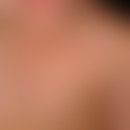DefinitionThis section has been translated automatically.
The term "facial edema" is a purely descriptive macromorphological term for a multifactorial acute or chronic swelling of the face. It can be categorized according to acuteity (acute or chronic), course (single or recurrent) or etiology (see also facial swelling, differential diagnosis).
ClassificationThis section has been translated automatically.
Fcial angioedema (T78.3)
Polyetiologic, acute (within minutes or a few hours), single or recurrent at irregular intervals, persistent for 1-7 days, hereditary or acquired, non-itching, sometimes painful or "oppressive" swelling of the deep dermis, subcutis and/or mucosa/submucosa. The cause is mediator-mediated (histamine/bradykinin) vascular leakage. Swelling of the pharynx and/or larynx can be life-threatening. Facial swelling is particularly noticeable and frequent, as it leads to considerable disfigurement (see also angioedema of the head and neck region). More rarely, angioedema affects the limbs, the genital area or the gastrointestinal tract).
- Histamine-mediated angioedema (most common cause of acquired facial angioedema (type: acute spontaneous urticaria). This can occur as:
- Spontaneous idiopathic acute angioedema (variant of spontaneous idiopathic acute urticaria (L50.8)
- Spontaneous symptomatic acute angioedema(variant of spontaneous symptomatic acute urticaria (L50.8)
-
Hereditary angioedema (D84.1)
Hereditary angioedema with mutation in the C1 esterase inhibitor gene
Hereditary angioedema without detectable mutation in the SERPING1 gene
- Non-histamine-mediated angioedema (pseudoangioedema):
- ACE angioedema ( T73.3) (captopril, enalapril, ramipril)
- Sartan angioedema/sartans= At1 blockers(candesartan, losartan)
- NSAIDs-angioedema (T73.3)
- mTOR inhibitor-induced angioedema(sirolimus, everolimus) (Beaini H et al.2024)
- Tyrosine kinase inhibitors (e.g. dasatinib/Nyckowski T et al. 2022)
- Antipsychotics (e.g. olanzapine/Malhotra M et al. 2013),
- Neuroleptics such as risperidone (periorbial swelling Pelizza L 2008)
- Angioedema after biologics (e.g. dupilumab as an anti-IL4 receptor blocker)
Other edema of the face
- Allergic: insect bites, food, allergic contact dermatitis; actinic dermatitis
- Toxic: acute toxic dermatitis (prototype: dermatitis solarius, toxic vapors)
- Traumatic/surgical: after blunt trauma, after dental surgery; subcutaneous emphysema after dental surgery; toxic/allergic reactions to cosmetic filler therapies
- Infectious: tooth root granulomas, acute erysipelas (A46.-fiery red painful swelling), trichinellosis (B75.x0), loiasis (B74.30), Chagas disease (B57.2), infectious mononucleosis (B57.9). Preferably eyelid edema due to: blepharitis, sinusitis, bacterial conjunctivitis.
- Endocrinologic: Myxoedema diffuse (E03.8) in severe hypothyroidism (doughy swelling); Cushing's syndrome (E24.9/moon face, spongy bloated)
- Inflammatory: Morbihan's disease (L71.8/deep red doughy non-painful swelling, Melkersson-Rosenthal syndrome (G51.2/solid tissue compaction, little reddening)
- Autoimmunological: dermatomyositis (M33.-), systemic lupus erythematosus (M32.9/ heliotropic saturated red swelling), statin-induced necrotizing myopathy; urticarial vasculitis (M31.8), eosinophilic episodic angioedema (T78.3)
- Obstructive: superior vena cava syndrome (livid or skin-colored swellings); angiosarcoma of the scalp (C44.-/livid red swellings, vascular drawings); lymphoma, congestive heart disease (blue swellings, dyspnea)
- Idiopathic: mucinosis (L98.5/rigeous, skin-colored swellings); granulomatous rosacea (L71.8/red facial mask with follicular papules), Clarkson's disease(capillary leakage syndrome)
- Degenerative: Blepharochalasis syndrome(H02.3): Recurrent swelling of the eyelids. The acute phase lasts from hours to days (average 2 days). In this phase there is painless edema usually combined with erythema. The patient may also complain of a "red eye" and lacrimation.
LiteratureThis section has been translated automatically.
- Velasco-Amador JP et al. (2024) If not angioedema, what is it? Diagnostic approach to facial edema. J Dtsch Dermatol Ges 22: 501-512.
Outgoing links (29)
ACE inhibitor-induced angioedema; Acetylsalicylic acid; Angioedema episodic with eosinophilia; Angioedema hereditary ; Angioedema of the head and neck region; Angioedema (overview); Angiosarcoma of the head and face skin; Blepharochalasis syndrome; Candesartan; Capillary leak syndrome; ... Show allDisclaimer
Please ask your physician for a reliable diagnosis. This website is only meant as a reference.



